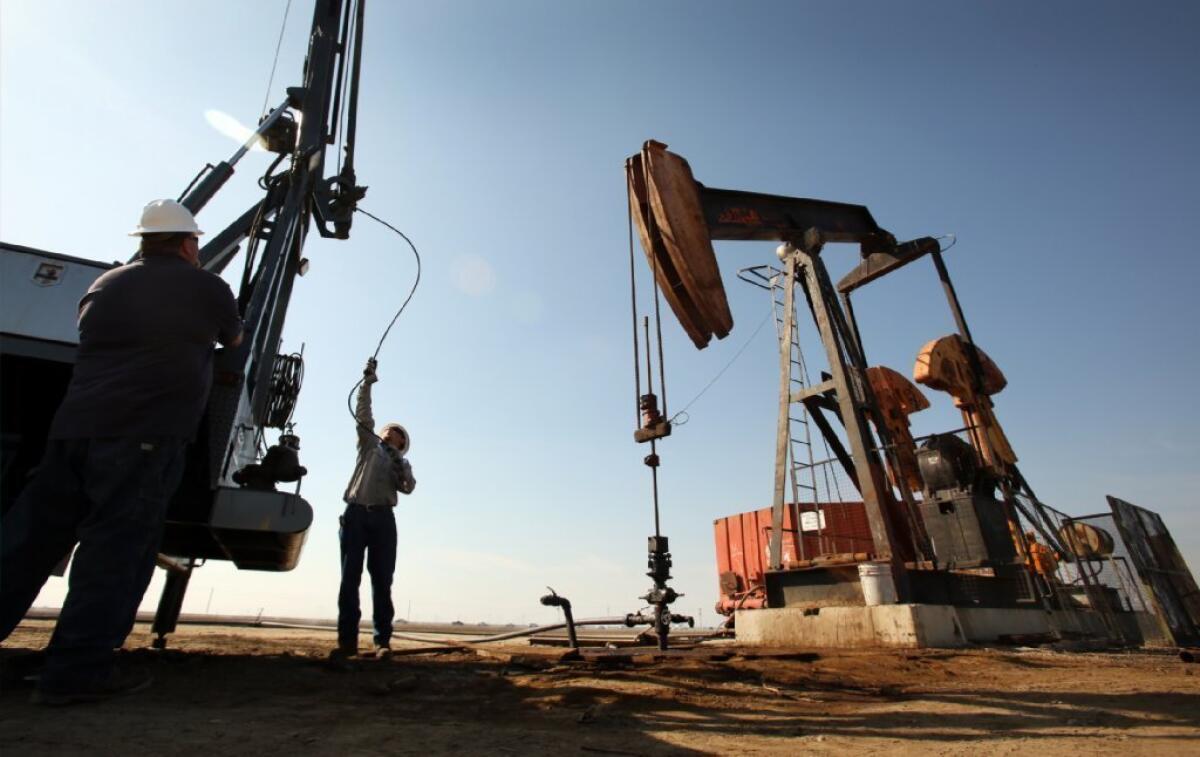Christmas surprise: Oil companies oppose an oil tax -- with falsehoods

The oil industry believes that a state oil severance tax in California would be “bad tax policy” and threaten the state’s economy. It thinks my arguments in favor of the tax, which were laid out a couple of weeks ago, are “misleading.”
We know the industry’s mind because it was described by Catherine Reheis-Boyd, president of its West Coast lobbying arm, the Western States Petroleum Assn., in an essay for The Times published on Christmas Eve.
That “misleading” charge is especially amusing, because of the nature of Reheis-Boyd’s counter-arguments. Given that this is the Christmas season, it’s perhaps too harsh to call them lies. Let’s just say her points are “disingenuous,” which, to paraphrase Mark Twain, is “lying” with a college education.
Reheis-Boyd’s fight isn’t really with me, but with Tom Steyer, the Silicon Valley billionaire who’s bankrolling an educational campaign aimed at getting the Legislature to pass a severance tax. He observes that California is unique among major oil-producing states in not taxing petroleum as it comes out of the ground (hence, “severance” tax). He estimates that a severance tax could bring the state as much as $2 billion a year in revenue.
But because I wrote approvingly of Steyer’s effort, I’ll accept the challenge of addressing Reheis-Boyd’s points one by one.
First, she asserts that the state actually does tax oil. “California’s property taxes and high business income and sales taxes,” she writes, “practically substitute for a severance tax.”
I acknowledged in my post that California does levy some taxes on oil. I further observed that the state’s levies are laughably small compared with those of other oil-producing states. According to Steyer, Texas takes an average of $14.33 a barrel, for example; California takes $4.22. (Reheis-Boyd doesn’t challenge Steyer’s figures in her piece.)
So when Reheis-Boyd says that California’s taxes “practically substitute” for other states’ severance taxes, it’s unclear what she means by “practically.” If she means they bring in “just about as much,” she’s blowing smoke.
She maintains that my comparison of California’s taxes with Texas’ is unfair, because California has a corporate income tax and Texas doesn’t have an income tax. But Texas does have a corporate income tax -- it’s just not called that. It’s called a “franchise” tax, and it’s designed to bring in as much as $6 billion a year (though it’s fallen short of projections recently). That’s about 75% of California’s take from its corporate income tax in 2012.
Reheis-Boyd also observes that although California has the highest sales tax rates in the nation, Alaska, a huge oil producer, doesn’t have a sales tax at all. That’s true, but beside the point. The consulting firm LEGC determined in 2008 that California’s sales tax would cost a “benchmark” average publicly traded oil firm about $23 million to $24 million a year. It also found that Alaska’s severance tax costs the same benchmark firm about $110 million a year.
Reheis-Boyd probably knows this, because LEGC made its determinations in a report commissioned by her organization. So much for California taxes being a “practical substitute” for a severance tax.
She further asserts that Alaska’s 25% severance tax, instituted by then-Gov. Sarah Palin in 2007, has been “reduced and simplified this year.” She says that’s because “with the higher rate in place, Alaska had suffered a significant decline in oil production. It simply didn’t work for Alaska, and it won’t work for California.”
Here’s where Reheis-Boyd edges beyond “disingenuous” and comes awfully close to lying. Alaska’s oil production peaked at about 2 million barrels a day back in 1988, a good decade before Palin raised the severance tax. Production has declined every year but two since then. Since the 2007 tax, production has continued to fall at pretty much the annual average, reaching 526,000 barrels a day in 2012.
So the production decline had absolutely nothing to do with the severance tax. Alaska’s decision to reduce the tax, which will cost it $2 billion a year or about one-third of its oil revenues, probably had more to do with the industry getting its talons into the state Legislature than with any linkage between the tax and oil production.
As for the rest of Reheis-Boyd’s arguments, they come straight from the industry’s tax-fighting playbook, including the claim that the tax will raise taxes at the pump and cost the state production jobs. The first of those arguments was conclusively debunked years ago: Retail prices track the cost of crude on the world markets, not the cost of local production.
The second argument swears at common sense: There’s only one place to drill for California oil, and that’s California. Drillers make their decisions based also on the world price of oil, on which state severance taxes have virtually an invisible effect.
The bottom line is that California ranks ninth or 10th among oil-producing states in its taxation of that “benchmark” oil company, according to another 2008 LEGC study, this one for the state of Colorado. LEGC’s study for Reheis-Boyd’s group placed California sixth.
Reheis-Boyd last week wrung her hands over the supposedly “inaccurate” claims Steyer has made for the severance tax. “Beginning an education campaign on inaccurate claims doesn’t bode well for the quality of the educational experience,” she lamented in a piece for the San Francisco Chronicle.
She’s right about that, at least.







